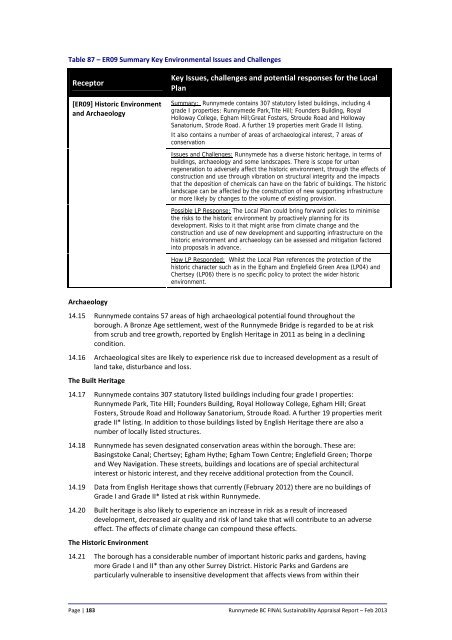DRAFT Sustainability Appraisal Report for the Emerging Local Plan ...
DRAFT Sustainability Appraisal Report for the Emerging Local Plan ...
DRAFT Sustainability Appraisal Report for the Emerging Local Plan ...
Create successful ePaper yourself
Turn your PDF publications into a flip-book with our unique Google optimized e-Paper software.
Table 87 – ER09 Summary Key Environmental Issues and Challenges<br />
Receptor<br />
[ER09] Historic Environment<br />
and Archaeology<br />
Key Issues, challenges and potential responses <strong>for</strong> <strong>the</strong> <strong>Local</strong><br />
<strong>Plan</strong><br />
Summary: Runnymede contains 307 statutory listed buildings, including 4<br />
grade I properties: Runnymede Park,Tite Hill; Founders Building, Royal<br />
Holloway College, Egham Hill;Great Fosters, Stroude Road and Holloway<br />
Sanatorium, Strode Road. A fur<strong>the</strong>r 19 properties merit Grade II listing.<br />
It also contains a number of areas of archaeological interest, 7 areas of<br />
conservation<br />
Issues and Challenges: Runnymede has a diverse historic heritage, in terms of<br />
buildings, archaeology and some landscapes. There is scope <strong>for</strong> urban<br />
regeneration to adversely affect <strong>the</strong> historic environment, through <strong>the</strong> effects of<br />
construction and use through vibration on structural integrity and <strong>the</strong> impacts<br />
that <strong>the</strong> deposition of chemicals can have on <strong>the</strong> fabric of buildings. The historic<br />
landscape can be affected by <strong>the</strong> construction of new supporting infrastructure<br />
or more likely by changes to <strong>the</strong> volume of existing provision.<br />
Possible LP Response: The <strong>Local</strong> <strong>Plan</strong> could bring <strong>for</strong>ward policies to minimise<br />
<strong>the</strong> risks to <strong>the</strong> historic environment by proactively planning <strong>for</strong> its<br />
development. Risks to it that might arise from climate change and <strong>the</strong><br />
construction and use of new development and supporting infrastructure on <strong>the</strong><br />
historic environment and archaeology can be assessed and mitigation factored<br />
into proposals in advance.<br />
How LP Responded: Whilst <strong>the</strong> <strong>Local</strong> <strong>Plan</strong> references <strong>the</strong> protection of <strong>the</strong><br />
historic character such as in <strong>the</strong> Egham and Englefield Green Area (LP04) and<br />
Chertsey (LP06) <strong>the</strong>re is no specific policy to protect <strong>the</strong> wider historic<br />
environment.<br />
Archaeology<br />
14.15 Runnymede contains 57 areas of high archaeological potential found throughout <strong>the</strong><br />
borough. A Bronze Age settlement, west of <strong>the</strong> Runnymede Bridge is regarded to be at risk<br />
from scrub and tree growth, reported by English Heritage in 2011 as being in a declining<br />
condition.<br />
14.16 Archaeological sites are likely to experience risk due to increased development as a result of<br />
land take, disturbance and loss.<br />
The Built Heritage<br />
14.17 Runnymede contains 307 statutory listed buildings including four grade I properties:<br />
Runnymede Park, Tite Hill; Founders Building, Royal Holloway College, Egham Hill; Great<br />
Fosters, Stroude Road and Holloway Sanatorium, Stroude Road. A fur<strong>the</strong>r 19 properties merit<br />
grade II* listing. In addition to those buildings listed by English Heritage <strong>the</strong>re are also a<br />
number of locally listed structures.<br />
14.18 Runnymede has seven designated conservation areas within <strong>the</strong> borough. These are:<br />
Basingstoke Canal; Chertsey; Egham Hy<strong>the</strong>; Egham Town Centre; Englefield Green; Thorpe<br />
and Wey Navigation. These streets, buildings and locations are of special architectural<br />
interest or historic interest, and <strong>the</strong>y receive additional protection from <strong>the</strong> Council.<br />
14.19 Data from English Heritage shows that currently (February 2012) <strong>the</strong>re are no buildings of<br />
Grade I and Grade II* listed at risk within Runnymede.<br />
14.20 Built heritage is also likely to experience an increase in risk as a result of increased<br />
development, decreased air quality and risk of land take that will contribute to an adverse<br />
effect. The effects of climate change can compound <strong>the</strong>se effects.<br />
The Historic Environment<br />
14.21 The borough has a considerable number of important historic parks and gardens, having<br />
more Grade I and II* than any o<strong>the</strong>r Surrey District. Historic Parks and Gardens are<br />
particularly vulnerable to insensitive development that affects views from within <strong>the</strong>ir<br />
Page | 183 Runnymede BC FINAL <strong>Sustainability</strong> <strong>Appraisal</strong> <strong>Report</strong> – Feb 2013

















